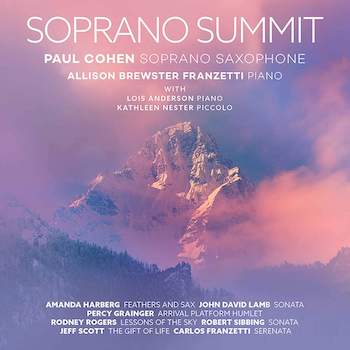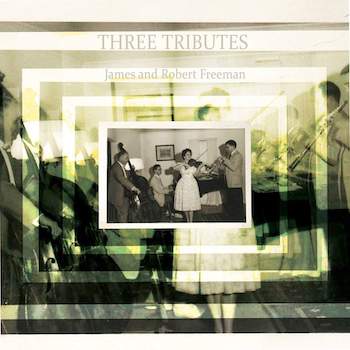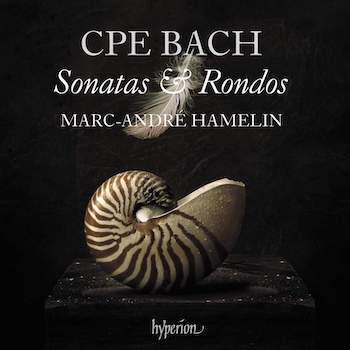Listening During Covid, Part 9: Intriguing New Works and New-Sounding C. P. E. Bach
By Ralph P Locke
A varied buffet of fresh musical experiences from recent decades and from the mid-1700s
Soprano Summit. Paul Cohen, soprano sax, and assisting artists. Ravello 8062.
Three Tributes. Robert Freeman, James Freeman, and Gilbert Kalish, pianists; Gloria Justen, violin; and other artists. Innova 989.
C. P. E. Bach, Sonatas and Rondos [and Other Pieces]. Marc-André Hamelin, piano. Hyperion CDA68381/2.
To purchase and to listen to tracks, click here: soprano sax, 3 tributes, or C.P.E. Bach. All three recordings are also available on Spotify and other streaming services.
Though concerts and operas are coming back to life, I’m still avoiding crowded gatherings. I therefore remain immensely grateful that recording companies are bringing fascinating new repertory to my ears. Three recent releases grabbed my attention and held it: a collection of chamber works with soprano saxophone; a disc of three pieces for quite varied forces commissioned in memory of a married musician-couple; and a 2-CD set of sonatas and other pieces by C. P. E. Bach, played on the modern piano by one of our day’s leading virtuosi, Marc-André Hamelin.
 The saxophone is an instrument that some of us adore. It can sound unpleasant when played coarsely, but that’s true of any instrument. Paul Cohen, who teaches at the Manhattan School of Music and at Rutgers, has been tireless in scouting out pieces for saxophone that deserve to be heard — or even eliciting brand-new ones — and playing them to perfection, as I reported in regard to his previous CD. His latest release, Soprano Summit, offers little-known pieces — all either previously unrecorded or heard here in an unrecorded version for saxophone — by American and America-based composers. The oldest piece is the Arrival Platform Humlet that Percy Grainger composed in 1906 in order to suggest the range of thoughts that might go through a person’s mind when waiting for a beloved one to arrive by train. Originally composed for solo viola, it works beautifully in Cohen’s transcription for soprano sax. Grainger was a big advocate of the saxophone; a photograph in the booklet shows the young composer holding one, as if ready to play.
The saxophone is an instrument that some of us adore. It can sound unpleasant when played coarsely, but that’s true of any instrument. Paul Cohen, who teaches at the Manhattan School of Music and at Rutgers, has been tireless in scouting out pieces for saxophone that deserve to be heard — or even eliciting brand-new ones — and playing them to perfection, as I reported in regard to his previous CD. His latest release, Soprano Summit, offers little-known pieces — all either previously unrecorded or heard here in an unrecorded version for saxophone — by American and America-based composers. The oldest piece is the Arrival Platform Humlet that Percy Grainger composed in 1906 in order to suggest the range of thoughts that might go through a person’s mind when waiting for a beloved one to arrive by train. Originally composed for solo viola, it works beautifully in Cohen’s transcription for soprano sax. Grainger was a big advocate of the saxophone; a photograph in the booklet shows the young composer holding one, as if ready to play.
The other six pieces were composed in recent decades, as recently as 2019. The composers are, by order of birth, Robert Sibbing (1929-2017), John David Lamb, Carlos Franzetti, Rodney Rogers, Jeff Scott, and Amanda Harberg. The best-known name here, to me, was Jeff Scott. Scott was for many years the hornist in the internationally acclaimed Imani Winds, a wind quintet honored with a permanent installation at the Smithsonian Museum of African American History. He composed The Gift of Life for piccolo and saxophone quartet, and it has been recorded in that form. Paul Cohen’s arrangement, made in 2021 for three players (piccolo, saxophone, and piano, with the sax player occasionally trading soprano for alto), should make the piece easier to program. The Gift of Life shows Scott as a composer who can speak vividly to a modern-day listener. Each of the three movements is shorter than four minutes, yet put together they create a satisfying whole, with an arc that moves from happy busy-ness to tragedy, mourning, and then consolation. (The piece was written in memory of a young American flute player who died young in a car accident in Austria just before she was to start her studies at the Vienna Conservatory.)
The other five pieces are all for soprano sax and piano. Harberg’s Feathers and Sax (2019) is her own adaptation of a piece she composed a few years earlier for flute and piano, entitled (wittily) Feathers and Wax. It was, she writes, “inspired by the Greek myth of Icarus. Through virtuoso writing with occasional jazz influences, Feathers depicts the brash young Icarus reveling in the thrill of flight.” The lightness of a soprano saxophone makes it a perfect medium for the quick, soaring lines of Harberg’s piece. The frequent syncopated rhythms resemble those in certain jazz-influenced works by Leonard Bernstein (e.g., his one-act opera Trouble in Tahiti).
John David Lamb has written extensively for saxophone (including a symphony for large saxophone ensemble). His three-movement sonata, completed in 1988, uses material first drafted in 1961 and feels like Hindemith in a less abrasive mood: I was reminded of such composers as Paul Creston (whose alto saxophone sonata is a staple of the repertory) and Harold Shapero. Rodney Rogers’s piece, like Harberg’s, has a title that invokes the vastness of the realm above us: Lessons of the Sky. (The phrase comes from a book by science writer Loren Eiseley.) In nine minutes, this work from 1985 traverses a wide range of moods, including a slow middle section in which the two instruments do, almost magically, seem to soar aloft in great expanses.
Robert Sibbing was an important saxophonist who also taught composition, and his two skills brilliantly intertwine in a three-movement sonata (1973) that is more directly romantic in feeling than anything else on the disc, with lovely sequences reminiscent at times of Ravel, at others of Rachmaninoff. Carlos Franzetti’s four-minute Serenata from 2019 (originally for clarinet and piano) is chock full of references to lively dance-music rhythms of Latin America, such as the Argentine (and Uruguayan) milonga and the Brazilian chorinho. It brings this CD — like a good concert — to a satisfying conclusion.
Performances throughout are wonderfully assured; Cohen gets superb support from pianist Lois Anderson in Lamb’s sonata and by Allison Brewster Franzetti in five other pieces. Don’t be afraid of the piccolo in Jeff Scott’s piece: Kathleen Nester plays it with a full, rounded tone very different from the spiky noise that one often hears on recordings and in live performances, and she interacts with Cohen’s saxophone in a very musical, thoughtful manner.
 A fascinating CD brings us three new works, all composed in 2005 or later and commissioned by brothers Robert and James Freeman (separately or together) in memory of their parents Henry and Florence, who were prominent musicians in Rochester and Boston during the 1930s-60s (respectively, bassist and violinist). Robert Freeman is a renowned music-school administrator — he headed the Eastman School of Music, in a firm and far-sighted manner, during the first half of my years on the faculty there — and James Freeman taught for decades at Swarthmore and founded (in 1988) and long conducted Philadelphia’s contemporary-music ensemble Orchestra 2001.
A fascinating CD brings us three new works, all composed in 2005 or later and commissioned by brothers Robert and James Freeman (separately or together) in memory of their parents Henry and Florence, who were prominent musicians in Rochester and Boston during the 1930s-60s (respectively, bassist and violinist). Robert Freeman is a renowned music-school administrator — he headed the Eastman School of Music, in a firm and far-sighted manner, during the first half of my years on the faculty there — and James Freeman taught for decades at Swarthmore and founded (in 1988) and long conducted Philadelphia’s contemporary-music ensemble Orchestra 2001.
In 2005 the Freeman family and the University of Texas commissioned from renowned then-young composer Kevin Puts a piece that would use the same forces for which Schubert composed the “Trout” Quintet. Both works use the unusual combination of piano, violin, viola, cello, and double-bass. The Galveston TX seafood restaurant that co-commissioned Puts’s piece was given the chance to name the new piece and opted for Texas’s official fish: “The Red Snapper.” Composer-critic Allen Gimbel, in American Record Guide, calls the work “impressive and expressive,” and indeed it’s a keeper, which I predict will be paired at times with the Schubert work — and maybe even start a trend for other pieces for this same combination of instruments. (There are by now several pieces for the five instruments used in Schoenberg’s Pierrot lunaire.)
The presence of a double-bass gives an orchestral solidity to the sound. All three movements play intriguingly with contrasting scales (whole-note vs. diatonic and chromatic), while exploring a wide range of moods, especially the last movement, which is in theme-and-variations form. I was particularly captivated by the first movement: a threnody that moves forward pace by pace, implacably but persuasively, throughout its seven-plus minutes, reminding me how stirred I was at the world premiere (by the Ying Quartet) of Puts’s 1999 Dark Vigil for string quartet, which was inspired by a horrifying series of school shootings across America.
Andrea Clearfield offers a nineteen-minute Romanza for Violin and Chamber Orchestra (2007), really a concerto in several connected sections, including two cadenzas. There are also solo passages for oboe, double-bass, and piano (instruments that were — like the violin — played across the decades by one or more members of the Freeman family). This Romanza is a delight to the ear, sometimes evoking the bittersweet moods of Samuel Barber’s famous violin concerto (1939) and even, toward the end, a bit of late Brahms. It makes me eager to hear more of Clearfield’s music.
 The last (and most recent) piece is a Sonata for Two Pianos, Four Hands (2010), by the late Gunther Schuller. Though modest in scale — its three movements are each about four minutes long — it is much gnarlier in style than, say, his one-act opera The Fisherman and His Wife (which I greatly enjoyed). I’m still trying to get my ears around it, but I am beginning to take delight in some of the more dancelike and caressingly melodic sections. The rather Bartókian final movement, full of lively shifts of mood and gesture, could easily become an effective encore (if one ever does such things in a two-piano recital)!
The last (and most recent) piece is a Sonata for Two Pianos, Four Hands (2010), by the late Gunther Schuller. Though modest in scale — its three movements are each about four minutes long — it is much gnarlier in style than, say, his one-act opera The Fisherman and His Wife (which I greatly enjoyed). I’m still trying to get my ears around it, but I am beginning to take delight in some of the more dancelike and caressingly melodic sections. The rather Bartókian final movement, full of lively shifts of mood and gesture, could easily become an effective encore (if one ever does such things in a two-piano recital)!
Music from previous centuries can also sound surprising and new. That’s the message I took from Marc-André Hamelin’s astonishing album of twenty works — many of them multi-movement sonatas — by Carl Philipp Emanuel Bach, the second son of Johann Sebastian Bach and renowned, even today, as an influential innovator. Hardly a few measures go by without some angular shift in the melodic line or unpredictable change of harmony.
A number of the pieces here — including one of my favorites, the Fantasia in C Major — are from the six collections of keyboard works “for connoisseurs and amateurs” that C. P. E. published in 1779-87. Some could be easily played by intermediate-level pianists. But Hamelin, a musician of superlative gifts, makes us feel as if the composer has returned to Earth, discovered the glories of the modern piano, and is improvising the music in front of us. This impression holds not just for the fantasias (a genre whose very name evokes a spirit of playful imaginativeness and formal freedom) but also for the sonatas and rondos. I feel I understand, even more than before, why Haydn, Mozart, and Beethoven all admired this astonishingly creative figure.
Ralph P. Locke is emeritus professor of musicology at the University of Rochester’s Eastman School of Music. Six of his articles have won the ASCAP-Deems Taylor Award for excellence in writing about music. His most recent two books are Musical Exoticism: Images and Reflections and Music and the Exotic from the Renaissance to Mozart (both Cambridge University Press). Both are now available in paperback; the second, also as an e-book. Ralph Locke also contributes to American Record Guide and to the online arts-magazines New York Arts, Opera Today, and The Boston Musical Intelligencer. His articles have appeared in major scholarly journals, in Oxford Music Online (Grove Dictionary), and in the program books of major opera houses, e.g., Santa Fe (New Mexico), Wexford (Ireland), Glyndebourne, Covent Garden, and the Bavarian State Opera (Munich).
Tagged: Amanda Harberg, Gilbert Kalish, Gunther Schuller, Hyperion, Innova, James Freeman, Marc-Andre Hamelin, Paul Cohen, Ralph P. Locke, Ravello, Robert Freeman, Robert Sibbing
